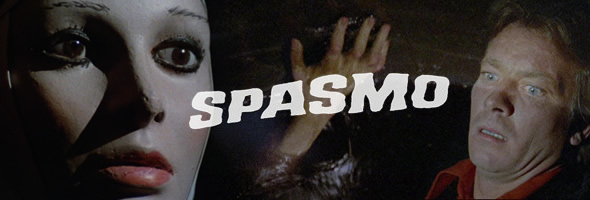

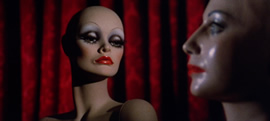 So out there it almost dares viewers to still classify it in the giallo category, this convoluted but
So out there it almost dares viewers to still classify it in the giallo category, this convoluted but 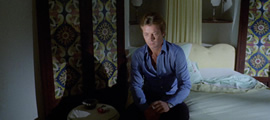 strangely effective study in madness offers a surprising change of pace from the normally commerce-minded director Umberto Lenzi. One of the most prolific of all the Italian thriller filmmakers, Lenzi had already established himself with a string of efficient, sometimes inspired offerings like Paranoia, So Sweet... So Perverse, the superlative Oasis of Fear, A Quiet Place to Kill, Seven Bloodstained Orchids, and Knife of Ice, but here he really broke with the formula to create a film that still baffles and beguiles in equal measure. From here the only place left to go was to push the subgenre into ridiculous excess, which Lenzi handily accomplished with his last giallo, the insane Eyeball.
strangely effective study in madness offers a surprising change of pace from the normally commerce-minded director Umberto Lenzi. One of the most prolific of all the Italian thriller filmmakers, Lenzi had already established himself with a string of efficient, sometimes inspired offerings like Paranoia, So Sweet... So Perverse, the superlative Oasis of Fear, A Quiet Place to Kill, Seven Bloodstained Orchids, and Knife of Ice, but here he really broke with the formula to create a film that still baffles and beguiles in equal measure. From here the only place left to go was to push the subgenre into ridiculous excess, which Lenzi handily accomplished with his last giallo, the insane Eyeball.  After he calls her a "sweet, sweet whore," she offers to take him back to her place for a quick one... on the condition that he shave off his beard ("There's a razor at my place; it's big, sharp, and sexy"). Naturally he complies, but before the two can consummate, he's ambushed in the bathroom by a pistol-wielding thug who winds up getting shot in the ensuing scuffle. Without even bothering to see the body, Barbara accepts Christian's word and goes on the lam with him to a friend's house, a desolate villa filled with birds of prey. Unfortunately they're surprised again by a couple renting the property, but Christan and Barbara are allowed to stay the night (even after explaining why they're hiding from the police). Christian decides to elicit help from his industrialist brother, Fritz (genre regular Rassimov), but the events of the evening and following day put
After he calls her a "sweet, sweet whore," she offers to take him back to her place for a quick one... on the condition that he shave off his beard ("There's a razor at my place; it's big, sharp, and sexy"). Naturally he complies, but before the two can consummate, he's ambushed in the bathroom by a pistol-wielding thug who winds up getting shot in the ensuing scuffle. Without even bothering to see the body, Barbara accepts Christian's word and goes on the lam with him to a friend's house, a desolate villa filled with birds of prey. Unfortunately they're surprised again by a couple renting the property, but Christan and Barbara are allowed to stay the night (even after explaining why they're hiding from the police). Christian decides to elicit help from his industrialist brother, Fritz (genre regular Rassimov), but the events of the evening and following day put 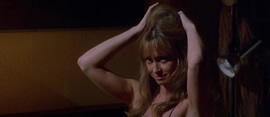 several kinks in his plan. Meanwhile, women around the countryside are dropping dead thanks to a mysterious killer, and female mannequins with knives in their torsos keep turning up at inopportune moments.
several kinks in his plan. Meanwhile, women around the countryside are dropping dead thanks to a mysterious killer, and female mannequins with knives in their torsos keep turning up at inopportune moments. 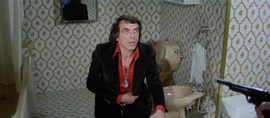 What saves the film entirely is its increasing atmosphere of mental disintegration, creating the feeling that the viewer himself is losing his mind. Never one of Euro cinema's stronger actors, Hoffman (billed here under that spelling instead of the German "Hoffmann" he normally used) is put to good use here as the wide-eyed protagonist; Kendall doesn't fare quite as well, spending her early scenes spouting cringe-inducing dialogue while modeling a lousy hairstyle, but her appearance and acting both improve as the film goes along. Then there's the final act of the film, which essentially redeems all the random nuttiness preceding it; if you can get through to this point, the story does pay off. Lenzi was only rarely an aesthetically interesting director, but here he executes some beautiful scope imagery and is helped along by a marvelous Ennio Morricone score (one of his best). The disorienting locales - beachscapes, rocky terrains, forests - in the opening movements effectively give way to more modern, stylized settings for the final stretch, leading to a claustrophobic, oddly resonant coda.
What saves the film entirely is its increasing atmosphere of mental disintegration, creating the feeling that the viewer himself is losing his mind. Never one of Euro cinema's stronger actors, Hoffman (billed here under that spelling instead of the German "Hoffmann" he normally used) is put to good use here as the wide-eyed protagonist; Kendall doesn't fare quite as well, spending her early scenes spouting cringe-inducing dialogue while modeling a lousy hairstyle, but her appearance and acting both improve as the film goes along. Then there's the final act of the film, which essentially redeems all the random nuttiness preceding it; if you can get through to this point, the story does pay off. Lenzi was only rarely an aesthetically interesting director, but here he executes some beautiful scope imagery and is helped along by a marvelous Ennio Morricone score (one of his best). The disorienting locales - beachscapes, rocky terrains, forests - in the opening movements effectively give way to more modern, stylized settings for the final stretch, leading to a claustrophobic, oddly resonant coda. 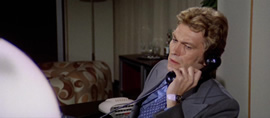 degeneration. Crackling and ambient noise are distracting in quieter scenes, but fortunately the score sounds fine and robust. Color and detail look fine, with occasional bursts of red pleasingly vivid. Extras include the hilarious theatrical trailer ("Spasmo! Spasmo!! Spasmo!!!"), a handful of other Shriek Show trailers, and most significantly, a video interview with Lenzi featuring a number of dubious claims (apparently off the cuff): this film is the final part of a trilogy with Paranoia and A Quiet Place to Kill; Hoffman was a fine and neglected leading man for Visconti; and George Romero should feel disgraced for shooting gory inserts for Spasmo's U.S. release (of which no physical evidence seems to exist despite years of rumors). As always he's fun to listen to and offers some good insights into the film, but take it all with more than a few grains of salt.
degeneration. Crackling and ambient noise are distracting in quieter scenes, but fortunately the score sounds fine and robust. Color and detail look fine, with occasional bursts of red pleasingly vivid. Extras include the hilarious theatrical trailer ("Spasmo! Spasmo!! Spasmo!!!"), a handful of other Shriek Show trailers, and most significantly, a video interview with Lenzi featuring a number of dubious claims (apparently off the cuff): this film is the final part of a trilogy with Paranoia and A Quiet Place to Kill; Hoffman was a fine and neglected leading man for Visconti; and George Romero should feel disgraced for shooting gory inserts for Spasmo's U.S. release (of which no physical evidence seems to exist despite years of rumors). As always he's fun to listen to and offers some good insights into the film, but take it all with more than a few grains of salt.  In 2015, Scorpion revisited the film for a Blu-ray release as well as a DVD reissue complete with a brand new 1080p presentation as well as the Lenzi interview and trailer. Interestingly, the Italian licensor provided the film with a transfer filtered with some noise reduction, though it's not plagued by that splotchy pastel nightmare effect that's plagued numerous Italian-sourced HD titles in the past. (Still looking at you, The 10th Victim.) However, they also provided the original raw scan before the filtering was applied, and both are included on the Blu-ray for comparison. Most viewers will probably opt for the "unfixed," pre-filtered version since it has a bit more detail and plays more cinematically in motion with more natural textures, but it actually isn't a massive difference. If you like your film grain on the more subdued side, the first, filtered option isn't catastrophic either. For example, the shot on the left (click to enlarge) is taken from the non-filtered transfer (yes, it's supposed to look grainy and gauzy like that), and here's the same shot from the noise reduced transfer; note the difference in Suzy Kendall's cheeks. (And what the heck, here's the same shot from the old Media Blasters DVD.) All the other images here are taken from the pre-filtered transfer. Audio is presented in mono DTS-HD MA and sounds substantially improved across the board, either with the standard English track or the Italian version with optional English subtitles. Only Kendall's real voice is heard in the English version, but all of the leads clearly spoke English during filming and remain in synch more or less throughout; it's the more preferable option overall, but the Italian track also has its elegant charms and is worth a watch as well.
In 2015, Scorpion revisited the film for a Blu-ray release as well as a DVD reissue complete with a brand new 1080p presentation as well as the Lenzi interview and trailer. Interestingly, the Italian licensor provided the film with a transfer filtered with some noise reduction, though it's not plagued by that splotchy pastel nightmare effect that's plagued numerous Italian-sourced HD titles in the past. (Still looking at you, The 10th Victim.) However, they also provided the original raw scan before the filtering was applied, and both are included on the Blu-ray for comparison. Most viewers will probably opt for the "unfixed," pre-filtered version since it has a bit more detail and plays more cinematically in motion with more natural textures, but it actually isn't a massive difference. If you like your film grain on the more subdued side, the first, filtered option isn't catastrophic either. For example, the shot on the left (click to enlarge) is taken from the non-filtered transfer (yes, it's supposed to look grainy and gauzy like that), and here's the same shot from the noise reduced transfer; note the difference in Suzy Kendall's cheeks. (And what the heck, here's the same shot from the old Media Blasters DVD.) All the other images here are taken from the pre-filtered transfer. Audio is presented in mono DTS-HD MA and sounds substantially improved across the board, either with the standard English track or the Italian version with optional English subtitles. Only Kendall's real voice is heard in the English version, but all of the leads clearly spoke English during filming and remain in synch more or less throughout; it's the more preferable option overall, but the Italian track also has its elegant charms and is worth a watch as well. ![]()